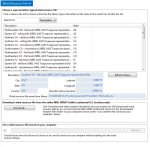What we don't have much experience with are the newer lithium batteries combining with a grid tied inverter. And I do not think we have ever done a grid tied wind system, only fully off grid.
but hey, why not?
Ok, here you go- there are more inverter options with the 48V lithium model than the 400V, for LG batteries.
Hope that helps. And here's another 48V maker:
https://d1819pwkf4ncw.cloudfront.net/files/documents/bmz-usa-ess-70-datasheet-12-1-2015-344595.pdf
This is on the last page of the link below-
400V residential:
Compatible Inverter Brands : SMA , SolarEdge (As of 3Q. 2016, More brands to be added)
48V residential:
Compatible Inverter Brands :
SMA, SolaX, Sungrow, Schneider, Ingeteam, GoodWe, Redback, Victron Energy
(As of 3Q. 2016, More brands to be added)
https://d3g1qce46u5dao.cloudfront.net/data_sheet/ess_lgchem_eng_0_.pdf
The wind maps just dont have enough resolution to be treated as gospel.
Sure then can be used as a guide or for rough figures.
Perhaps you should ask your client who is paying 40 grand for wind turbine set up if a wind study is over doing it. Very very very few people have a good wind site.
I lived off grid with a wind turbine for 5 years, and spend three years before that researching and planning it out. I would not recommend small wind to anyone, with just about the only exception being if it is hobby you really really like. Even assuming an excellent wind site, The capital costs are very high, and it is unlikely to be maintenance free. I have been up on my tower 80 feet in the air when the wind is blowing 30 MPH and it is 5 degrees out to fix a frayed wire or lubricate the furling pivot. Oh, and its a 1500' hike up a 45 degree slope with two feet of snow to get the base of the tower. IMO the way to go for off grid is an over-paneled PV system, with a modest battery bank, a generator, and an inverter with generator support. Many people make the mistake in off grid of being overly reluctant to run their generator. They either throw lots of money at batteries and panels thinking they can minimize/eliminate generator usage, and/or they hold off running the genny until the batteries are near dead. The key is to instead not sink all that money into a huge battery bank and use the generator to help out "as you go". That is the most cost effective way anyway. If money is not an issue, I guess we would need to know what the goal is then.
If the location is smack in the middle of a wind map zone, the reality will be fairly close.
Building codes are based on maximum wind speeds, using the same data, those are legit.
You can say "it'll take 10-12 years to pay back that $40,000, depending on actual wind speeds after installation".
There's no reason to use 6 m/s "as gospel" even in the middle of a 6 m/s zone- you can plug in 5.5 m/s and 5 m/s and see how it affects the $$ with SAM.
Bergey has a 5/10 year warranty, (no customers climbing towers) which is part of the higher price.
http://bergey.com/documents/2012/05/excel-10-warranty-statement.pdf


